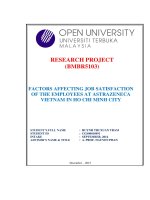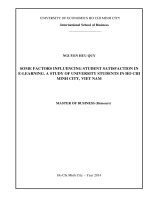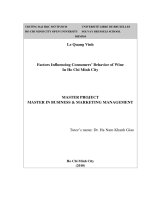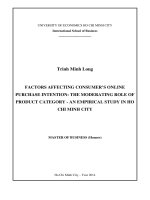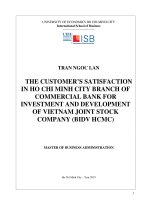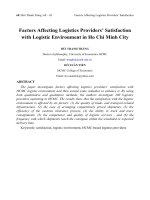FACTORS AFFECTING STUDENTS ONLINE PURCHASES SATISFACTION IN HO CHI MINH CITY
Bạn đang xem bản rút gọn của tài liệu. Xem và tải ngay bản đầy đủ của tài liệu tại đây (636.5 KB, 38 trang )
HO CHI MINH CITY UNIVERSITY OF FOREIGN LANGUAGES
AND INFORMATION TECHNOLOGY
BUSINESS ADMINISTRATIONS
---------***--------
FACTORS AFFECTING STUDENTS' ONLINE PURCHASES
SATISFACTION IN HO CHI MINH CITY
Full name: Trần Hoàng Vy
ID: 21DH483276
ABTRACT
The rapid growth of e-commerce has revolutionized the way consumers purchase
products and services, and students in particular have become an increasingly important
segment of online shoppers. This research aims to investigate the factors influencing
students' satisfaction with online purchases in Ho Chi Minh City, Vietnam. Understanding
these factors is crucial for online retailers and policymakers to develop effective strategies
that enhance customer satisfaction and improve the overall online shopping experience for
students.
The study employs a mixed-methods research approach, combining qualitative and
quantitative techniques. A comprehensive literature review is conducted to identify key
determinants that may influence students' satisfaction with online purchases.
Overall, this research contributes to the existing literature by specifically focusing on
factors affecting students' online purchase satisfaction in Ho Chi Minh City. By addressing
the unique characteristics and preferences of this target group, it offers practical implications
for businesses and policymakers in Vietnam's dynamic e-commerce landscape.
TABLE OF CONTENT
CHAPTER I: INTRODUCTION................................................................................1
1.1.
Overviews..........................................................................................................1
1.2.
Reason for topic.................................................................................................1
1.3.
Research Objectives..........................................................................................2
1.4.
Research Scope..................................................................................................2
CHAPTER II: LITERATURE REVIEW...................................................................4
2.1.
Definition of online shopping...........................................................................4
2.1.1.
Definition of e-commerce..............................................................................4
2.1.2.
Definition of online shopping........................................................................5
2.1.3.
Benefits of online shopping...........................................................................5
2.2.
Definition of customer satisfaction...................................................................6
2.2.1.
Definition of customer satisfaction...............................................................6
2.2.2.
The importance of improve customer satisfaction......................................7
2.3.
Differences in students' online shopping behavior and satisfaction..............8
2.4.
Reference model................................................................................................9
2.4.1.
Research model of Ho and Wu (1999)..........................................................9
2.4.2.
Research model of Guo et al. (2012).............................................................9
2.4.3.
Research model of Trang (2014).................................................................11
2.4.4.
Research model of Giang (2018).................................................................11
2.4.5.
Research model of Wolfinbarger and Gilly (2003)....................................12
2.5.
Overview of previous research.......................................................................13
CHAPTER III: METHODOLOGY..........................................................................14
3.1.
Research model and research hypothesis......................................................14
3.1.1.
Research model............................................................................................14
3.1.2.
Research hypothesis.....................................................................................14
3.2.
Research question...........................................................................................15
3.3.
Research design...............................................................................................16
3.3.1.
3.4.
Research objectives and methods...............................................................16
Research methods...........................................................................................17
3.4.1.
Qualitative research.....................................................................................17
3.4.2.
Quantitative research..................................................................................17
3.4.3.
Methods of processing research data.........................................................18
3.5.
Research process.............................................................................................19
3.6.
The method of data collection........................................................................20
3.6.1.
Primary research.........................................................................................20
3.6.2.
Secondary research......................................................................................23
CHAPTER IV: RESULTS.........................................................................................24
4.1.
Description of the research sample................................................................24
4.2.
Result of model regression..............................................................................26
4.3.
Discussing the research results.......................................................................28
4.3.1.
Security.........................................................................................................28
4.3.2.
Website design..............................................................................................28
4.3.3.
Customer Service.........................................................................................28
4.3.4.
Delivery service............................................................................................28
4.3.5.
Product diversity..........................................................................................29
4.3.6.
Product quality............................................................................................29
REFERENCES...........................................................................................................30
CHAPTER I: INTRODUCTION
1.1. Overviews
Online shopping can be considered as a popular consumption trend in most
countries with developed economies in the world. The appearance of a series of ecommerce websites such as Tiki, Lazada, Shopee... has made the online shopping
market in Vietnam more exciting. In addition, more and more young people are
participating in shopping with the interaction of social media networks such as
Facebook, Zalo and most recently, Tiktok. Since then, the trend of online shopping has
been increasingly developed and shows the importance of commerce and services.
Online shopping has become a fertile and potential land for retailers to exploit and
promises to bring many benefits to consumers.
Especially during and after the Covid-19 epidemic, due to travel restrictions and
social distancing, the demand for shopping through online channels is increasing day
by day. According to Google (2022), in 2021, the number of Vietnamese people
shopping online will reach more than 51 million, up 13.5% over the previous year,
total spending on online shopping will reach 12 .42 billion USD. Accordingly,
Vietnam's prediction of the digital economy by 2025 will exceed 52 billion USD and
be one of the top three markets in the region. According to the Ministry of Industry
and Trade (2021), the percentage of Vietnamese people using the Internet that
contributes to online shopping behavior in 2020 will reach about 88%, compared to
77% in 2019. With the entry and competition of many new suppliers along with the
increasing popularity of e-commerce, measuring customer satisfaction has become
very important for online shopping and for researchers.
1.2. Reason for topic
Consumers spend money to use the service and satisfaction will determine the
consumer's next purchase behavior, so the customer's satisfaction should be paid
attention to by administrators. In order to build an appropriate and effective policy to
1
improve customer experience, managers need to know what factors customers are not
satisfied with and its impact on customers' satisfaction. is high or low. From those
insights, businesses can develop policies to further improve the quality of services and
customer experience, thereby increasing consumers' attachment to the brand. .
In Vietnam, there have also been many other studies conducted to find and
evaluate the factors that may affect customers' satisfaction in the context of shopping
through online channels, such as Trang (2014); Nhu et al. (2016), Giang (2018) …
However, with the rapid development of science and technology (Science and
Technology), along with the fluctuations of the economy in the past period, it has also
changed. change consumer habits and behavior, especially after the Covid-19
pandemic. Therefore, it is very important to focus on finding and assessing the
influence of factors on customers' satisfaction in the context of online shopping at this
stage. Besides, most of the previous studies were general research for consumers, not
many studies really focused specifically on an object. With the above arguments, the
researcher boldly chose the topic "Factors affecting satisfaction when buying online by
students in Ho Chi Minh City" as the topic.
1.3. Research Objectives
This study was conducted with the following main objectives:
Firstly, systematize the theoretical framework related to customer's satisfaction
and factors affecting customer's satisfaction in the context of online shopping of
consumers in general and students in particular.
Second, identify the influencing factors and estimate the impact of those factors
on the satisfaction of students in Ho Chi Minh City when buying online.
Third, propose some suitable solutions for businesses associated with the
research paper to improve the satisfaction of the student customer segment in Ho Chi
Minh City in the context of online shopping.
1.4. Research Scope
Research objective: factors affecting satisfaction when buying online by students
in Ho Chi Minh City.
Research scope:
2
-
Spatial scope: Ho Chi Minh city
-
Time range: Primary data is collected in 2023
3
CHAPTER II: LITERATURE REVIEW
2.1. Definition of online shopping
2.1.1. Definition of e-commerce
“E-commerce” is also known by many different names such as: online commerce,
paperless commerce, e-business… (Hong and Thoa, 2012). However, e-commerce is still
the most popular name and is widely used in research works in this field. Up to now,
there is no fixed concept of e-commerce. From different perspectives, different research
will define e-commerce differently, but in general, scholars have pointed out that ecommerce can be considered from two angles: broad and narrow meanings (Hong and
Thoa, 2012).
According to WTO (2020), e-commerce includes a chain of actions from
production, communication and promotion through the Internet, but the customer will
receive the product organically. According to the Trans-Pacific Dialogue Forum (1997),
transactions of goods or services established through electronic devices are referred to as
e-commerce. According to EITO (1997) the performance of business transactions where
value is transferred through telecommunications networks is called e-commerce. In
Vietnam, according to Hong and Thoa (2012), from a narrow perspective, trading
activities through the Internet are called e-commerce. For example, buying through ecommerce platforms such as Shopee, Lazada or social networks Facebook, Tiktok Shop
is an e-commerce activity.
In summary, whether in a broad or narrow sense, the views on e-commerce can be
understood more simply than buying and selling goods and services on the Internet. Ecommerce in reality is extremely rich and diverse, so it is difficult for us to define it
exactly. It includes not only main activities such as sales, collection of money, but also
marketing activities, customer care, ... they are especially important for both sellers and
buyers. Especially when the Internet develops at a rapid pace and the epidemic situation
is complicated and difficult to control, the role of e-commerce has become an important
field for consumers in many places.
4
2.1.2. Definition of online shopping
Online shopping is an important part of e-commerce. According to Jusoh and Ling
(2012), online shopping is defined as the customer taking various steps to purchase a
service or product over the Internet. It means going online, visiting a seller's website,
choosing something and arranging for delivery. Buyers make payment for products or
services online by credit card, debit card, bank transfer or in person upon delivery.
According to Trang (2014), online shopping is when consumers directly make purchases
of goods and services from sellers through the internet without any other intermediary.
Shopping and delivery are all via email, customers cannot touch or feel the items, so the
interaction between buyers and sellers is mainly based on trust, unlike traditional retail.
2.1.3. Benefits of online shopping
In the digital era, a series of new business models based on the application of
science and technology have been born, in which it can be said that the explosion of ecommerce leads to a change in customer behavioral intentions while shopping. Modern
consumers increasingly prefer online shopping because of the convenience and
usefulness that it brings. The growth of e-commerce has also led to a revolution in the
way businesses do business at retailers. Doing business through online channels helps
businesses increase productivity, reach customers in a wider environment, and improve
order accuracy. With the benefits that online shopping brings to buyers, besides, it also
makes them change their previous behavior. Nowadays, online shopping is really
becoming a rapidly growing phenomenon. More and more consumers are shopping
online to purchase goods and services.
Some of those benefits include:
Firstly, online shopping helps customers save time and shop more flexibly. In
today's busy life, many people cannot arrange to move between stores to shop, so sitting
at home or office and just using electronic devices connected to the Internet is an option.
Getting the products you want is considered the biggest advantage of online shopping.
Online shopping helps consumers reduce the time it takes to sort through products and
services. They also take less time to resolve invoice and order discrepancies.
Furthermore, consumers can shop online 24 hours a day. This is because e-commerce is
open for 365 days and never closes even for a minute.
5
Second, when compared with traditional shopping, the convenience of consumers in
online shopping is far superior. Instead of having to worry about traffic problems when
shopping directly at the store and transporting goods from the store to home, online
shopping brings comfort to consumers when they do not have to go out. If you have to
carry heavy goods home, all the goods can be delivered to your home instead.
Third, online shopping helps consumers easily compare prices to choose the most
optimal price. For online shopping, just through a few clicks, customers will have access
to information about the price of each product of each brand and each store. The process
of comparing prices and product quality between different brands and stores will help
users make the optimal consumption choice and suit their needs.
Fourth, online shopping often has incentives with discount codes for customers to
buy goods at the best price. Platforms that provide online shopping often offer discounts,
promotions, and free shipping policies... so that consumers can save money on online
shopping. This process helps customers increase the perceived value of online shopping
and bring them satisfaction.
Fifth, on online shopping sites, there are often reviews of old customers about
products - services they have purchased and used. This will be a useful source of
information to help consumers make the most appropriate and optimal choice of products
and services.
Finally, along with the advancement of e-commerce, more and more electronic
payment methods appear to increase the convenience for users. Instead of receiving
goods and then paying, now, consumers can also safely use online payment services via
e-wallets, cards, accounts, etc. With the temporary payment feature, absolute buyer
protection offers a variety of payment services, customers can exchange goods, can
complain, give suggestions, ... and get help and support 24 /7.
2.2. Definition of customer satisfaction
2.2.1. Definition of customer satisfaction
Although customer satisfaction has been a topic of interest to many researchers for
decades, it is still a controversial term among scholars. There is no unified definition of
customer satisfaction. Based on different research approaches and objectives, researchers
6
offer different concepts of satisfaction. According to Johnson et al. (1995), after
customers use the product or service, there will be a response of satisfaction or
disappointment. This feeling arises due to the difference in expectations before
consumption and perceived after actual consumption. According to Oliver et al. (1997),
customer satisfaction is the difference between customers' expectations and actual
perceptions while Westbrook (1987) thinks that customer satisfaction is the customer's
perception of products or services they use. According to Zeithaml and Bitner (2000),
customers' assessment of the degree to which a product or service meets their needs and
expectations is customer satisfaction. Meanwhile, according to Kotler (2000), satisfaction
is the consumer's feeling of satisfaction or disappointment after using it based on the
comparison between expectations and actual feelings after use. Although there are many
different definitions, in general, satisfaction is understood as the difference between
customer expectations and the actual perception received.
Thus, consumer satisfaction is the result of a comparison between expectations and
experiences; In other words, consumers are satisfied when in the process of experiencing
products or using services, they feel satisfied or even more than their expectations.
Satisfaction and loyalty are important factors affecting the strong development of
businesses in the market because satisfied customers are the ones who will repeat the
purchase if the service provider achieves or exceed their expectations.
2.2.2. The importance of improve customer satisfaction
In the fiercely competitive market economy, improving customer satisfaction has
become a strategy that many businesses are interested in because it benefits businesses in
establishing long-term relationships with customers. customers thus clearly position the
brand in the market. The study of customer satisfaction also helps businesses have a basis
to innovate and improve products and services that are close to the tastes and needs of
customers, thereby stimulating customers to experience and stick with them. with more
brands.
Expectations when shopping are mostly formed from past buying experiences, word
of mouth information from people around such as family, friends, colleagues, and
information received through business activities. communication and promotion of
products and services. When the actual buying experience does not meet the expectations
7
of consumers, they will tend to be disappointed and will spread word of mouth to those
around them. Therefore, learning about customer satisfaction has become an annual
activity in businesses. A high level of satisfaction can bring many benefits to a business.
First of all, the likelihood of a satisfied customer returning to use a product or service is
very high, so a high level of customer satisfaction will improve customer loyalty and
attachment to the brand. Besides, satisfied customers can introduce products and services
of the business to their surroundings, so the business cannot need to promote and still get
new customers thereby increasing sales. revenue and profit. Improving customer
satisfaction also helps businesses save money because serving old customers always costs
less than serving a new customer. At the same time, a customer with a high level of
satisfaction is willing to pay more for a company's other product or service.
Most businesses today realize the rapid change in customer behavior and
continuously follow the movement of the economy along with the increasingly fierce
competition of the market economy. Therefore, they need to take specific actions to
increase their competitive advantage and in which improving customer satisfaction is an
indispensable thing for any business that wants to maintain the sustainability of the
market. Because customer satisfaction is the key to turning new customers into loyal
customers and is a free advertising channel for businesses to attract more new customers.
Improving customer satisfaction is considered an important tool that can help businesses
increase market share and dominate the market more quickly and effectively.
2.3. Differences in students' online shopping behavior and satisfaction
Online shopping trend is becoming a popular culture among young people,
especially students. It can be seen that students are the object of access to online
shopping very quickly because of their ability to access modern electronic devices such
as computers and phones to access the Internet and surf the web every day, so they are
important customer audience of online shopping business platforms. However, students
are also consumers with low income, so their ability to accept payment as well as the
items they choose to shop will also be different compared to the elderly customer group.
Besides, with the agility and understanding of technology, the behavioral intention and
satisfaction of this group of customers will also be different from that of the elderly group
who are able to access and use the technology is still limited. Because of these
8
differences, it is very necessary to study the factors affecting online shopping satisfaction
for students because this is a large customer group of this market and trends in attitudes,
behaviors and perceptions of services also differ from those of other consumer groups.
2.4. Reference model
2.4.1. Research model of Ho and Wu (1999)
Research model of Ho and Wu (1999) was conducted to study the influence of eservice quality on consumers' satisfaction when shopping online. The academics' sample
consisted of 79 random consumers who purchased from 5 online stores in Taiwan. The
researchers found that 5 factors have an impact on the satisfaction of survey participants
when shopping online on the Internet. Among them website presentation is a new and
unique element that has never existed in traditional marketing.
Figure 2.1 Research by Ho and Wu (1999)
2.4.2. Research model of Guo et al. (2012)
Guo et al. (2012) studied to determine the factors that affect satisfaction when
customers shop online. In the study, these scholars propose 8 aspects related to e-services
that can be predicted for satisfaction when making consumers' online shopping including
9
presentation and website design, security, information quality, payment method, e-service
quality, product quality, product variety and finally delivery service. Accordingly, the
factors mentioned above are expected to have the effect of promoting the improvement of
customers' satisfaction. They gathered from a survey of 350 customers who had ever
shopped in China to use as data for the study. Through multivariable linear regression
model estimation, the scholars found that all 8 factors proposed above have a positive
impact on consumers' satisfaction for online shopping in China.
Figure 2.2 Research model of Guo et al. (2012)
10
2.4.3. Research model of Trang (2014)
Trang (2014) conducted a study to assess the impact of e-service quality on
consumers' satisfaction in Ho Chi Minh City when shopping online. According to this
researcher, the quality of e-services provided is based on four factors including website
design, security, order fulfillment and finally system availability. Through a survey of
354 customers in Ho Chi Minh City. In Ho Chi Minh City, there is an online shopping
behavior, the researcher has built a data set for research. The results of the OLS
estimation for the multivariable linear regression model help the researcher to conclude
that the factors including order fulfillment, security, website design, and system
availability all have an impact. affect the customer's satisfaction when shopping online.
Figure 2.3 Research model of Trang (2014)
2.4.4. Research model of Giang (2018)
Giang (2018) studied the factors that affect the satisfaction of consumers in Bien
Hoa City when shopping online. In addition to factors related to e-service quality, the
researcher also considers the influence of demographic variables on consumers'
satisfaction when shopping online. The data is recorded by the researcher from 257 users
who have purchased online in the area. By estimating OLS with multivariable linear
regression model, Luu Hoang Giang discovered that when shopping online, there are 5
factors that affect customer satisfaction including website design, security, customer
11
service, utility, and finally product characteristics. In which, the two factors that have the
strongest impact on customer satisfaction are product characteristics and security.
Figure 2.4 Research model of Giang (2018)
2.4.5. Research model of Wolfinbarger and Gilly (2003)
Wolfinbarger and Gilly (2003) developed a scale to measure the quality of online
sales websites called eTailQ. The eTailQ scale has 4 main scales with 14 observed
variables. The scales that reflect the quality of online sales websites proposed by these
scholars include website design, trust, security and finally customer service. In there
-
Website design: refers to the attributes of an application or e-commerce website
such as product filters, navigability, accessibility, and ease of use.
-
Trust: the accuracy and truthfulness of the information posted on the application,
website, the ability to deliver on time and exactly as committed.
-
Security: the safety and protection of customer data, means of payment of the
website
-
Customer service: feedback and support to customers with problems related to
products, manners, behavior of staff in the process of helping, answering
customers' questions.
12
2.5. Overview of previous research
Thus, in the past decade, with the great progress of e-commerce and online
shopping, it has become a potential field and strong growth in many regions, including
developed and developing countries including Vietnam. Consumers are choosing to shop
online more and more, especially during the Covid-19 pandemic, consumers' online
shopping behavior has changed significantly. In Vietnam, the issue related to online
shopping has become a topic of interest to many policy makers, but research topics on
this topic are not really diverse, complete and up to date. In addition, most of the previous
research have only focused on the online shopping intention of consumers in Vietnam but
have not paid much attention to satisfaction as well as their loyalty when shopping
online. While there are not many studies aimed at students, even a large segment of the
online shopping market for businesses. These things create a research gap for the
researcher to carry out this topic.
13
CHAPTER III: METHODOLOGY
3.1. Research model and research hypothesis
3.1.1. Research model
The research model tested experimentally in this study is built based on the eTailQ
scale of Wolfinbarger and Gilly (2003), and some empirical studies on the topic
nationally and globally. The model considers factors affecting satisfaction of student
when online shopping in Ho Chi Minh City is proposed under diagram 2.5.
Figure 2.5 Research model proposed by the researcher
3.1.2. Research hypothesis
Hypothesis H1: Confidentiality has a positive impact on students' satisfaction in Ho
Chi Minh City when shopping online.
Hypothesis H2: Website design has a positive impact on the satisfaction of students
in Ho Chi Minh City when shopping online.
14
Hypothesis H3: Customer service has a positive impact on satisfaction of students
in Ho Chi Minh City when shopping online.
Hypothesis H4: Delivery service has a positive impact on satisfaction of students in
Ho Chi Minh City when shopping online.
Hypothesis H5: Product diversity has a positive impact on satisfaction of students in
Ho Chi Minh City when shopping online.
Hypothesis H6: Product quality has a positive impact on satisfaction of students in
Ho Chi Minh City when shopping online.
3.2. Research question
In this research, the researcher seeks to solve the following questions related to
satisfaction of students in Ho Chi Minh City when shopping online:
-
How does website design influence students' online purchase satisfaction in Ho
Chi Minh City?
-
What is the impact of security measures on students' satisfaction with their
online purchases in Ho Chi Minh City?
-
How does the delivery service affect students' satisfaction when making online
purchases in Ho Chi Minh City?
-
What is the relationship between product diversity and students' online purchase
satisfaction in Ho Chi Minh City?
-
How does product quality influence students' satisfaction with their online
purchases in Ho Chi Minh City?
-
What is the impact of system services, such as customer support and
return/exchange policies, on students' online purchase satisfaction in Ho Chi
Minh City?
-
Are there any significant differences in online purchase satisfaction among
students in Ho Chi Minh City based on website design, security, delivery
service, product variety, product quality, and system services?
-
Which independent variable(s) have the strongest impact on students' online
purchase satisfaction in Ho Chi Minh City?
15

